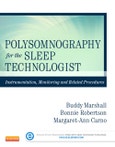- In-depth discussions of polysomnographic technology in the clinical evaluation, physiological monitoring and testing, instrumentation, diagnosis, infection control, management and prevention of a wide spectrum of sleep-related disorders and daytime alertness offers comprehensive coverage of polysomnography technology. - Expert content written by the same authors who were instrumental in producing a standardized model curriculum outline. - Unique sequential approach builds concepts over time and simplifies the material's complexity. - Over 150 full-color graphs, charts, and illustrations supply visual guidance. - End-of-chapter review questions help you assess your knowledge and prepare for certification as a sleep technologist. - Chapter outlines, learning objectives, key terms and a bulleted chapter summary supplies a standard format to help you identify and focus on key content.
Please Note: This is an On Demand product, delivery may take up to 11 working days after payment has been received.
Table of Contents
Chapter 1: Overview of Sleep Medicine, Sleep Physiology, and Polysomnographic Technology
Chapter 2: Classification of Sleep Disorders
Chapter 3: Electronics and Electricity
Chapter 4: Frequency, Voltage, and Morphology of Signals
Chapter 6: The Recording of Physiological Parameters and Electrical Safety
Chapter 7: Data Acquisition Systems
Chapter 8: Sensors, Transducers, and Ancillary Equipment
Chapter 9: The Polysomnogram: Pre-Study Procedures, Monitoring activities, and Post Study Scoring and Interpretation
Chapter 10: Recognizing, Evaluating, and Minimizing Artifacts During A Polysomnographic Recording
Chapter 11: The Cardiopulmonary System: Essentials for the Polysomnographic Technologist
Chapter 12: Non-Invasive Monitoring of Gas Exchange During Polysomnography
Chapter 13: Diagnosis, Treatment, and Outcome Management of Sleep-Disordered Breathing
Chapter 14: Infection Control and Emergent Response in the Sleep Center
Appendix I - Fundamental Math Concepts
Appendix II - Common Report Parameters and Recommended Settings
Appendix III - Measurements and Conversions
Glossary








